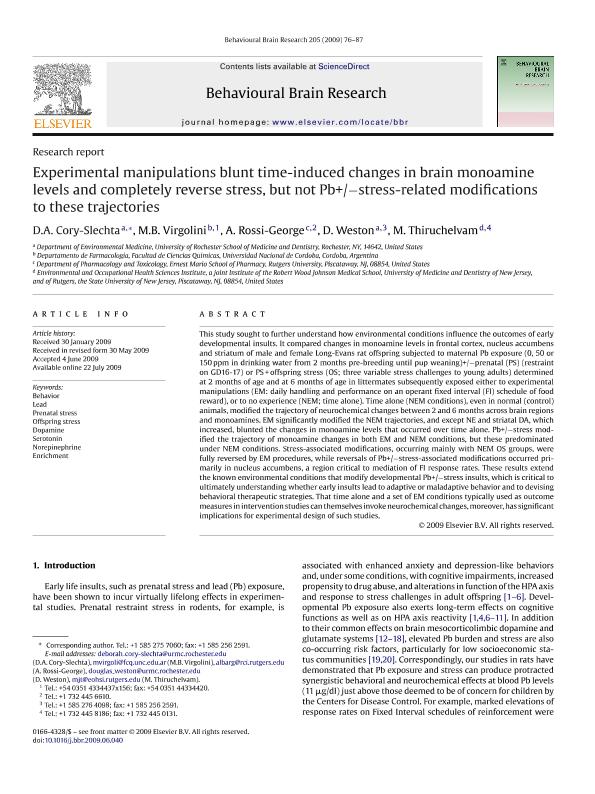Mostrar el registro sencillo del ítem
dc.contributor.author
Cory-Slechta, D. A.
dc.contributor.author
Virgolini, Miriam Beatriz

dc.contributor.author
Rossi-George, A.
dc.contributor.author
Weston, D.
dc.contributor.author
Thiruchelvam, M.
dc.date.available
2021-05-17T20:11:24Z
dc.date.issued
2009-12
dc.identifier.citation
Cory-Slechta, D. A.; Virgolini, Miriam Beatriz; Rossi-George, A.; Weston, D.; Thiruchelvam, M.; Experimental manipulations blunt time-induced changes in brain monoamine levels and completely reverse stress, but not Pb+/-stress-related modifications to these trajectories; Elsevier Science; Behavioural Brain Research; 205; 1; 12-2009; 76-87
dc.identifier.issn
0166-4328
dc.identifier.uri
http://hdl.handle.net/11336/132180
dc.description.abstract
This study sought to further understand how environmental conditions influence the outcomes of early developmental insults. It compared changes in monoamine levels in frontal cortex, nucleus accumbens and striatum of male and female Long-Evans rat offspring subjected to maternal Pb exposure (0, 50 or 150 ppm in drinking water from 2 months pre-breeding until pup weaning)+/-prenatal (PS) (restraint on GD16-17) or PS + offspring stress (OS; three variable stress challenges to young adults) determined at 2 months of age and at 6 months of age in littermates subsequently exposed either to experimental manipulations (EM: daily handling and performance on an operant fixed interval (FI) schedule of food reward), or to no experience (NEM; time alone). Time alone (NEM conditions), even in normal (control) animals, modified the trajectory of neurochemical changes between 2 and 6 months across brain regions and monoamines. EM significantly modified the NEM trajectories, and except NE and striatal DA, which increased, blunted the changes in monoamine levels that occurred over time alone. Pb+/-stress modified the trajectory of monoamine changes in both EM and NEM conditions, but these predominated under NEM conditions. Stress-associated modifications, occurring mainly with NEM OS groups, were fully reversed by EM procedures, while reversals of Pb+/-stress-associated modifications occurred primarily in nucleus accumbens, a region critical to mediation of FI response rates. These results extend the known environmental conditions that modify developmental Pb+/-stress insults, which is critical to ultimately understanding whether early insults lead to adaptive or maladaptive behavior and to devising behavioral therapeutic strategies. That time alone and a set of EM conditions typically used as outcome measures in intervention studies can themselves invoke neurochemical changes, moreover, has significant implications for experimental design of such studies.
dc.format
application/pdf
dc.language.iso
eng
dc.publisher
Elsevier Science

dc.rights
info:eu-repo/semantics/openAccess
dc.rights.uri
https://creativecommons.org/licenses/by-nc-sa/2.5/ar/
dc.subject
BEHAVIOR
dc.subject
DOPAMINE
dc.subject
ENRICHMENT
dc.subject
LEAD
dc.subject
NOREPINEPHRINE
dc.subject
OFFSPRING STRESS
dc.subject
PRENATAL STRESS
dc.subject
SEROTONIN
dc.subject.classification
Toxicología

dc.subject.classification
Medicina Básica

dc.subject.classification
CIENCIAS MÉDICAS Y DE LA SALUD

dc.title
Experimental manipulations blunt time-induced changes in brain monoamine levels and completely reverse stress, but not Pb+/-stress-related modifications to these trajectories
dc.type
info:eu-repo/semantics/article
dc.type
info:ar-repo/semantics/artículo
dc.type
info:eu-repo/semantics/publishedVersion
dc.date.updated
2021-04-23T17:14:54Z
dc.journal.volume
205
dc.journal.number
1
dc.journal.pagination
76-87
dc.journal.pais
Países Bajos

dc.journal.ciudad
Amsterdam
dc.description.fil
Fil: Cory-Slechta, D. A.. University of Rochester School of Medicine and Dentistry; Estados Unidos
dc.description.fil
Fil: Virgolini, Miriam Beatriz. Consejo Nacional de Investigaciones Científicas y Técnicas. Centro Científico Tecnológico Conicet - Córdoba. Instituto de Farmacología Experimental de Córdoba. Universidad Nacional de Córdoba. Facultad de Ciencias Químicas. Instituto de Farmacología Experimental de Córdoba; Argentina
dc.description.fil
Fil: Rossi-George, A.. Rutgers University; Estados Unidos
dc.description.fil
Fil: Weston, D.. University of Rochester School of Medicine and Dentistry; Estados Unidos
dc.description.fil
Fil: Thiruchelvam, M.. University of Medicine and Dentistry of New Jersey; Estados Unidos
dc.journal.title
Behavioural Brain Research

dc.relation.alternativeid
info:eu-repo/semantics/altIdentifier/doi/http://dx.doi.org/10.1016/j.bbr.2009.06.040
dc.relation.alternativeid
info:eu-repo/semantics/altIdentifier/url/https://www.sciencedirect.com/science/article/abs/pii/S0166432809004379
Archivos asociados
